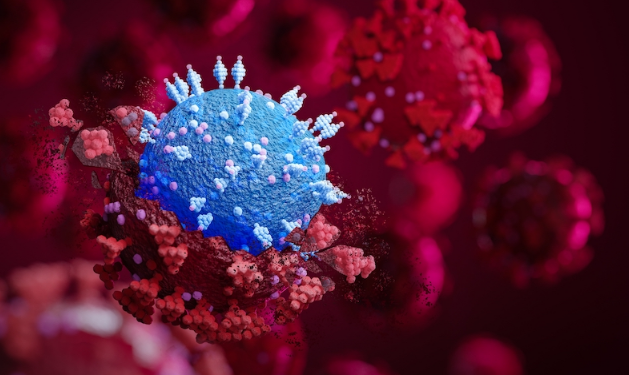
SARS-CoV-2 Protein Spreads Between Cells, Causing Immune System to Target Healthy Tissue
The SARS-CoV-2 virus, which causes COVID-19, may target cells it has never infected in order to induce immune-mediated tissue damage, according to a recent study that reveals an unexpected mechanism.
According to the study, which was published in Cell Reports, the virus’s nucleocapsid protein (NP), which is most well-known for its function in encasing viral RNA inside infected cells, is transported to nearby uninfected epithelial cells and adheres to their surfaces.
When NP is found on these apparently healthy cells, the immune system recognises it and anti-NP antibodies target it, incorrectly labelling the cells for destruction. Inflammation and cellular damage brought on by this process’ activation of the classical complement pathway may be a factor in the serious COVID-19 outcomes and consequences, including prolonged COVID.
This study reveals a startling method by which the SARS-CoV-2 virus can trick the immune system into attacking healthy cells just because a viral protein has been attached to them. The ongoing research in the labs that are spearheading this study aims to better understand this mechanism in order to develop novel ways for reducing immune-driven harm in COVID-19 and potentially other viral infections.
To learn more about how a particular viral protein known as the nucleocapsid protein binds to healthy cells, the researchers examined samples from COVID-19 patients, laboratory-grown cells, and advanced imaging tools. They observed that this protein binds to Heparan Sulphate proteoglycans, which are sugar-like molecules present on the surface of many cells.
Clumps of the viral protein develop on these healthy cells as a result. The immune system then unintentionally uses antibodies to target these clusters, causing a chain reaction that could harm the organism’s cells—both healthy and sick.
Additionally, the researchers discovered that the viral protein can be prevented from adhering to healthy cells by the medication enoxaparin, a frequently used blood thinner. As a heparin analogue, it accomplishes this by occupying the locations where the protein would typically bind. Enoxaparin prevented the protein from binding to cells and assisted in preventing the immune system from unintentionally attacking them in both laboratory tests and when patient samples were examined in a lab.
Under the direction of Ph.D. students Jamal Fahoum and Maria Billan from the Hebrew University of Jerusalem’s Faculty of Medicine, the laboratories of Dr. Alexander Rouvinski, Prof. Ora Schueler-Furman, and Prof. Reuven Wiener collaborated on the project. The further clinical data required for this investigation was supplied by clinicians Dr. Dan Padawer, Prof. Dana Wolf, and Dr. Orly Zelig, together with their colleagues from other departments at Hebrew University—Hadassah Medical Centre. The article’s authors dedicate it to the memory of the late Prof. Hervé (Hillel) Bercovier, a brilliant microbiologist, a remarkable mentor, and an inspiring scientist.
The Barry Skolnick Biosafety Level 3 (BSL3) National Unit, a newly constructed high biocontainment national laboratory inside the Core Research Facility of the Faculty of Medicine of the Hebrew University of Jerusalem, was the site of the SARS-CoV-2 infection experiments that were necessary for this study.






